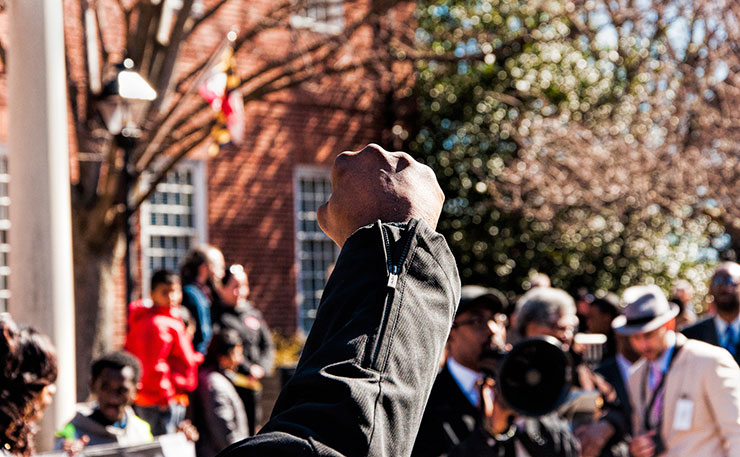Race relations have long been used as a powerful tool to divide, and to distract, writes Liam McLoughlin
In the early 18th century, Virginian legislators used racism to crush class solidarity. 300 years later on the other side of the world, not much has changed.
In 1676, an alliance of white indentured servants and African slaves, led by colonist Nathaniel Bacon, rose up against Virginian Governor William Berkeley in what was called Bacon’s Rebellion.
At the time the two social groups felt some solidarity, occupying similar positions in the social hierarchy. Court records show numerous instances of servants and slaves running away together. This growing solidarity terrified the ruling class and something had to be done to minimise future uprisings.
Authorities set about manufacturing differences between the two groups.
In the aftermath of Bacon’s Rebellion, the Virginian Assembly gave amnesty to white rebels, but not to African-Americans. From 1680, whites were allowed to give slaves 30 lashes should they offer any opposition. The Virginia Slave Codes of 1705 instituted a system of harsh punishments for slaves, including being whipped, branded or maimed for merely associating with whites.
Meanwhile, white servants finishing their servitude were rewarded with corn, cash, clothing, arms and 50 acres of land. Other laws forced plantation owners to hire a certain number of whites for every slave, and forced whites to serve in slave patrols.
According to theologian and scholar Dr Thandeka:
“As a result of these legally sanctioned changes in poor whites’ economic position, they gained legal, political, emotional, social, and financial status that depended directly on the concomitant degradation of Indians and [African Americans].”
Howard Zinn has also written about this process in A People’s History of the United States:
“Racism was becoming more and more practical. Edmund Morgan, on the basis of his careful study of slavery in Virginia, sees racism not as “natural” to black-white difference, but something coming out of class scorn, a realistic device for control. ‘If freemen with disappointed hopes should make common cause with slaves of desperate hope, the results might be worse than anything Bacon had done. The answer to the problem, obvious if unspoken and only gradually recognised, was racism, to separate dangerous free whites from dangerous black slaves by a screen of racial contempt.’”
The practice of using racism to divide, conquer and control populations has since spread far beyond slavery. According to Tess Lee Ack writing in the Marxist Left Review:
“The established ideas of the supposed inferiority of Africans could easily be extended to non-white races in Asia and other parts of the globe as they were subjected to nineteenth century European imperialist expansion in the form of colonialism. The subjugation of indigenous peoples, the disruption of their societies, the theft of their land, the destruction of their culture and the plundering of their resources were carried out by imperialist states and justified by racism.”
Though the protagonists, location and time periods vary, the use of racism to undermine class consciousness and transform justified anti-establishment sentiment into unjustified anger at minorities, remains something of a constant.
Ack accurately describes how it works:
“Racism allows white workers an illusory sense of power insofar as they see themselves as part of the dominant group in society, while at the same time providing scapegoats against whom to turn the anger that should properly be directed towards the ruling class. Today, it is the capacity of racism to divide the working class and divert workers’ discontent away from the capitalists and direct it towards the chosen scapegoats of the day which is most useful to the capitalist class.”
Whether fostering racial differences between white servants and African slaves in the United States in the 18th century, or nurturing Islamophobia in Australia in 2016, government authorities consistently turn to racism to displace blame and bolster their own political power.
As in the case of Virginia in the late 17th century, there is a clear relationship between threats to elite domination and spikes in racism. The greater the threat to governing power, the greater the need to divide and conquer populations by emphasising racial divisions.
As global economic insecurity has increased in recent years off the back of 30 years of neoliberal attacks on social democracy, world leaders have tried to limit public dissatisfaction with government by shifting the blame onto racial minorities.
The Australian experience bears this out. Recent Australian polls showing intensified Islamophobia reflect intensified efforts from ruling classes to cultivate these attitudes.
When Peter Dutton says illiterate and innumerate refugees will take Australian jobs and welfare, it’s the culmination of 15 years of anti-refugee, anti-Muslim propaganda.
When Malcolm Turnbull links terrorism with refugees, he’s invoking an age old means of social control to convince Australians that it’s Muslims, not government cuts to welfare, that are the primary threat to their well-being.
When Liberals court and embrace Pauline Hanson, they outsource vulgar racist sentiments while maintaining direct responsibility for institutional racism.
Much like in Virginia three centuries ago, this strategy is a sign of government weakness rather than strength, but over many centuries and across many countries it has proven successful in dividing populations against themselves and consolidating state power.
It’s something Marx wrote about in 1870 when he described the manufactured hostility between English and Irish workers which was “artificially kept alive and intensified by the press, the pulpit, the comic papers, in short, by all the means at the disposal of the ruling class”. He described this artificial antagonism as the “secret by which the capitalist class maintains its power”.
To the public at large, nearly 150 years later, it’s still a pretty well-kept secret.
Until a mass movement spills this secret and re-directs blame for economic insecurity towards the neoliberal ideologues responsible, those rulers will continue to divide us into servants and slaves.
Donate To New Matilda
New Matilda is a small, independent media outlet. We survive through reader contributions, and never losing a lawsuit. If you got something from this article, giving something back helps us to continue speaking truth to power. Every little bit counts.





